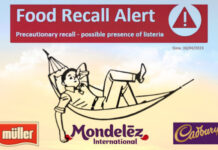An investigative report by the BLOOM association has raised the alarm over mercury contamination in 100% of canned tuna samples taken from supermarkets in five European countries. (1)
Tuna is the most consumed fish in Europe and is one of the most contaminated with mercury, but the limits for it established in the EU are higher than those for other fish. The Foodwatch petition.
1) Mercury, where is it found?
Mercury is a heavy metal that occurs naturally, at about 0.5 parts per million (ppm) in the Earth’s crust, and is released into the atmosphere through various industrial activities. It is deposited in water, where is converted by microorganisms into organic mercury (methyl or ethyl) and ingested by smaller creatures that are consumed by larger fish.
Pelagic fish, those at the top of the food chain, can concentrate considerable amounts of mercury in their tissues. (2) More than three thousand lakes in the United States have been closed to fishing because of mercury contamination, and many species of ocean fish are also contaminated with significant concentrations of mercury. (3)
2) Human exposure and toxicity
Human exposure to mercury occurs mainly through inhalation of its vapors, through occupational exposure or exposure to dental amalgam, or through ingestion of mercury through consumption of contaminated fish.
WHO lists mercury among the 10 substances of greatest concern for human health, along with asbestos and arsenic. Its derivative present in food, methylmercury, is classified as a possible carcinogen by the International Agency for Research on Cancer (IARC). (4)
This metal poisons cellular functions and can impair the function of any organ or subcellular structure. The main target organ of mercury vapor is the brain, but also peripheral nervous, renal, immune, endocrine and muscular functions. (2)
3) Mercury alarm in canned tuna, the BLOOM report
The BLOOM association analyzed 148 canned tuna purchased in five European countries (England, Germany, Italy, France and Spain), finding the following:
-100% of canned tuna tested by an independent laboratory was found to be contaminated with mercury;
-more than one in two cans (57%) exceeded the maximum mercury limit established in the EU for the species subject to the most restrictive limit (0.3 mg/kg);
-10% of the packages exceeded the food safety threshold established in the EU for fresh tuna (1mg/kg);
-the contamination record, 3.9 mg/kg, was reached by Petit Navire brand tuna, purchased in Paris in a Carrefour store. (1)
4) EU, ‘tailor-made’ safety thresholds for the tuna industry
BLOOM analyzed about a hundred official documents on mercury contamination and food safety, published by various international organizations (joint FAO-WHO committee, European Commission, EFSA).
‘Our investigation reveals that no method is used to define maximum levels of mercury in tuna that takes into account the health consequences for adults and children. On the contrary,
-European public authorities have chosen an approach completely at odds with their duty to protect public health:
-use the actual mercury contamination of tuna to set a threshold that guarantees the sale of 95% of them.
For this reason tuna, one of the most contaminated species, has a maximum mercury tolerance three times higher than that of the less contaminated species (1 mg/kg versus 0.3 mg/kg for cod, for example). There is no health reason for this discrepancy: mercury is not less toxic if ingested through tuna’. (1)
5) Which official controls?
‘Contrary to the vigilance that such a health problem should require, there are virtually no controls on the tuna production and marketing chain,’ continues BLOOM. ‘In the Seychelles, the nerve centre of tuna fishing for the European market, the health authorities only have to carry out about ten tests a year to ensure the conformity of thousands of tonnes of tuna sent to Europe.’ (5)
Official controls in the EU are also poor, as seen among other things in the case of the mega-fraud on defrosted tuna, which remains unsolved to this day (6,7). The documents collected by BLOOM show that in the whole of France the competent authorities do not even check a single canned fish, limiting themselves to analyzing less than fifty fresh tuna every year.
‘As far as we know,’ explains Julie Guterman of BLOOM , ‘a major importer like France has not carried out any checks on the contamination of canned tuna since 2023: not even one check per year. The public authorities do not even try to hide their complicity with the tuna industry. They have thus offered industrial fishermen and large distribution chains a license to contaminate.’
6) Foodwatch, the petition aimed at retail
The international consumer association Foodwatch has joined forces with BLOOM to launch an international petition aimed at retail players in Europe, including:
-Carrefour, Intermarché and Leclerc in France;
-also Carrefour, as well as Mercadona and Lidl, in Spain;
-Conad, Coop and Esselunga in Italy;
-Edeka, Rewe and Aldi in Germany.
Retail is asked to take responsibility for consumer health, through:
-strict controls on mercury contamination of canned tuna. As in fact it is the responsibility of the distributor (8)
-introduction of a more stringent threshold (0.3 mg/kg, instead of 1 mg/kg) on mercury levels in tuna products;
-suspension of all forms of advertising and promotion of tuna-based products;
-clear labelling on tuna products, offline and online, to inform consumers about the health risks associated with mercury contamination. (9)
7) Tuna Gate
Pandora’s box on the globalized industrial tuna supply chain is ready to be uncovered. The BLOOM report under examination is part of the larger investigation ‘Tuna Gate’, also dedicated to serious human rights violations and environmental crimes (IUU, Illegal, unreported and unregulated fishing).
ILO (International Labour Organization) and various organizations, as the author has been denouncing for years, have published numerous reports on slavery, illegal fishing (10,11). However, without receiving any concrete feedback from European and international political institutions.
Consumers – so far unaware of the serious problems that afflict this supply chain – may now perhaps review their purchasing choices in light of the serious emerging risks of food safety. Responsible industries will in turn be able to demonstrate their seriousness by registering in blockchain analyses on heavy metals and histamines.
Dario Dongo
Footnotes
(1) Bloom. Mercury contamination: Bloom exposes a health scandal on an unprecedented scale. 29.10.24 https://tinyurl.com/mr3ymtuu
(2) Bernhoft RA. Mercury toxicity and treatment: a review of the literature. J Environ Public Health. 2012;2012:460508. doi: 10.1155/2012/460508
(3) Nordberg GF, Fowler BA, Nordberg M, Friberg LT. Handbook on the Toxicology of Metals. Elsevier, 2015. ISBN 978-0-444-59453-2. https://doi.org/10.1016/C2011-0-07884-5
(4) WHO newsroom. Mercury. 24.10.24 https://tinyurl.com/3ehuyebu
(5) European Commission (2011). Audit of the Seychelles regulatory authority https://tinyurl.com/59696s3y
(6) Dario Dongo. Tuna thawed with additives, the giant food fraud unpunished in EU. FT (Food Times). 15.6.21
(7) Dario Dongo. Fraud on defrosted tuna, brief advice pending in Brussels. FT (Food Times). 31.8.21
(8) Dario Dongo, Pier Luigi Copparoni. Responsibility of the distributor, insights. GIFT (Great Italian Food Trade). 22.5.18
(9) Foodwatch. Tuna and mercury: large retailers must remove the poison from their shelves. Petition. 29.10.24 https://tinyurl.com/4athu5dv
(10) Dario Dongo. Slaves of tuna? A serious problem, be careful what we buy. GIFT (Great Italian Food Trade). 12.4.17
(11) Marta Strinati, Dario Dongo. Traceability of canned tuna. The pressure of IUUWatch on the European Commission. GIFT (Great Italian Food Trade). 18.2.21
Dario Dongo, lawyer and journalist, PhD in international food law, founder of WIISE (FARE - GIFT - Food Times) and Égalité.







